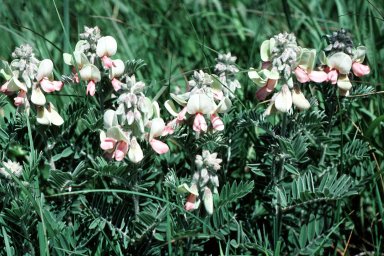Detail View: Kansas Wildflowers: Tephrosia virginiana (L.) Pers.

|
Catalog Number:
|
2754
|
|
Record ID:
|
KBS_LARC.2754_1200.Tep_vir2.tif
|
|
Global Unique Identifier:
|
URN:science:KBS:wildflower:2754
|
|
Institution Code:
|
KBS
|
|
Date Last Modified:
|
12/16/2004
|
|
Basis Of Record:
|
observation
|
|
Scientific Name:
|
Tephrosia virginiana (L.) Pers.
|
|
Family:
|
Fabaceae
|
|
Genus:
|
Tephrosia
|
|
Species:
|
virginiana
|
|
Scientific Name Author:
|
(L.) Pers.
|
|
State or Province:
|
Kansas
|
|
County:
|
Douglas
|
|
Locality:
|
Jct US 56 & Douglas Co 1055, 1.4 mi S. Pioneer Cemetery.
|
|
Physiographic Province:
|
Osage Cuestas
|
|
Associated Plant Community:
|
Tallgrass Prairie
|
|
Collector:
|
Craig C. Freeman
|
|
Date Collected:
|
5/30/1987
|
|
Rights:
|
Craig C. Freeman
|
|
Source:
|
Kansas Wildflowers Database, Kansas Biological Survey, University of Kansas
|
|
Genus Name Meaning:
|
From Greek tephros, "ash-colored"
|
|
Species Name Meaning:
|
of Virginia
|
|
Common Names:
|
Goat's rue
|
|
Common Names:
|
Catgut
|
|
Description:
|
Plant life form: Perennial
|
|
Description:
|
Height: 2-7 dm
|
|
Description:
|
Species description: Flowers have a prominent pale yellow to lemon yellow upper petal with remaining petals pink or rose. Flowers bloom from May to June.
|
|
Description:
|
Species description: Erect, hairy perennial herb with deep woody roots. One to several stems arise from the base and are unbranched or weakly branched above. Leaves are alternate and odd-pinnately compound with 7-31 leaflets.
|
|
Description:
|
Habitat: Prairies, open woods, sand dunes, and roadsides.
|
|
Description:
|
Range in Kansas: Eastern half of the state.
|
|
Description:
|
Edible uses: Plant contains rotenone which can be poisonous if ingested in large quantities
|
|
Description:
|
Medicinal Uses: Tea made from roots used to treat urinary infections, coughs and lung problems, fevers, and to expel worms. Also used to rinse hair to treat and prevent baldness.
|
|
Description:
|
Other uses: Plant contains rotenone which is an insecticide and causes paralysis and death in fish. Native American tribes used roots of plant when fishing to paralyze fish.
|
|
Description:
|
Warnings: POISONOUS--Plant contains rotenone which causes paralysis and death in fish and insects and can be poisonous to humans if ingested in large quantities.
|
|
Description:
|
Cultivation: Drought-tolerant. Grows best in dry, sandy, well-drained soil in full sun. Will adapt to poor soils.
|
|
Description:
|
Propagation: Seed--plant in fall.
|
|
Color:
|
Pinkish
|